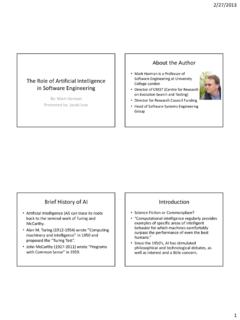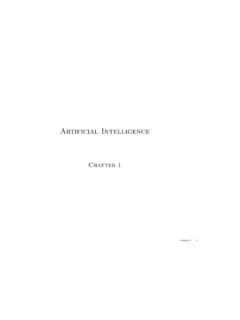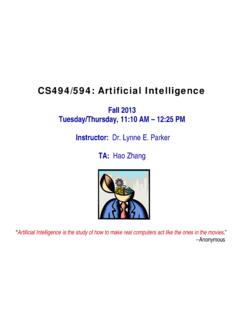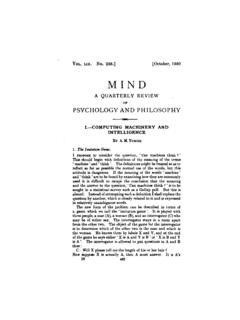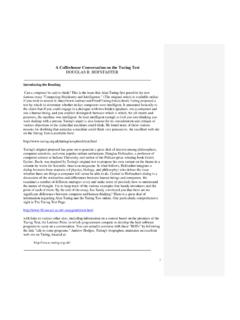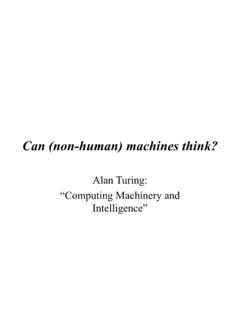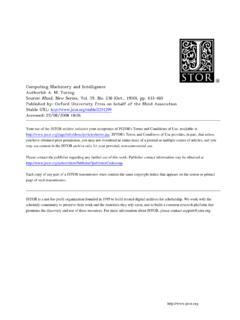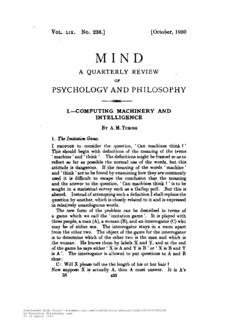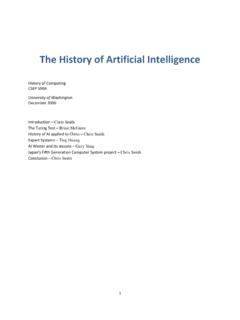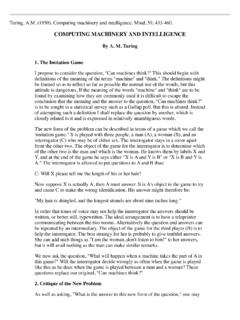Transcription of Chapter 3 Computing Machinery and Intelligence
1 Chapter 3 Computing Machinery and IntelligenceAlan M. TuringR. Epstein et al. (eds.), Parsing the Turing Test. 23 Springer 2008 Editors Note: The following is the article that started it all the article by Alan Turing which appeared in 1950 in the British journal, Mind. Accompanying the article are three running commentaries by Kenneth Ford, Clark Glymour, and Pat Hayes of the University of West Florida; Stevan Harnad of the University of Southampton; and Ayse Pinar Saygin of the University of California, San Diego, designated respectively by the symbols: , , and . A fourth commentary by John Lucas of Merton College, Oxford, is found in Chapter The Imitation GameI propose to consider the question, Can machines think?
2 This should begin with definitions of the meaning of the terms machine and think . The definitions might be framed so as to reflect so far as possible the normal use of the words, but this attitude is dangerous. If the meaning of the words machine and think are to be found by examining how they are commonly used it is difficult to escape the conclusion that the meaning and the answer to the question, Can machines think? is to be sought in a statistical survey such as a Gallup poll. But this is absurd. Instead of attempting such a definition I shall replace the question by Manchester University Harnad: Turing starts on an equivocation. We know now that what he will go on to consider is not whether or not machines can think, but whether or not machines can do what thinkers like us can do and if so, how.
3 Doing is performance capacity, empirically observable. Thinking is an internal state. It correlates empirically observable as neural activity (if we only knew which neural activity corresponds to thinking!) and its associated quality introspectively observable as our own mental state when we are thinking. Turing s proposal will turn out to have nothing to do with either observing neural states or introspecting mental states, but only with generating performance capacity indistinguishable from that of thinkers like A. M. Turinganother, which is closely related to it and is expressed in relatively unambiguous words. The new form of the problem can be described in terms of a game which we call the imitation game.
4 It is played with three people, a man (A), a woman Ford, Glymour, and Hayes: Turing derides deciding the question by an empirical survey of which sorts of objects the word think or its synonyms are positively applied to. Presumably, in 1950 people rarely if ever said of machines that they think, and few people in 1950 would have said that any machine, then or in the future, could possibly be said to think. The procedure is absurd because what people say, even what almost everyone agrees in saying, is often wildly wrong: a century before almost everyone would have agreed to the proposition that angels think. Harnad: Machine will never be adequately defined in Turing s paper, although what will eventually be known as the Turing Machine, the abstract description of a computer, will be.
5 This will introduce a systematic ambiguity between a real physical system, doing something in the world, and another physical system, a computer, simulating the first system formally, but not actu-ally doing what it does: an example would be the difference between a real airplane a machine, flying in the real world and a computer simulation of an airplane, not really flying, but doing something formally equivalent to it, in a (likewise simulated) virtual world. A reasonable definition of machine, rather than Turing Machine, might be any dynamical, causal system. That makes the universe a machine, a molecule a machine, and also waterfalls, toasters, oysters, and human beings.
6 Whether or not a machine is man-made is obviously irrelevant. The only relevant property is that it is mechanical , behaves in accordance with the cause-effect laws of physics. Think will never be defined by Turing at all; it will be replaced by an operational definition to the effect that thinking is as thinking does. This is fine, for thinking cannot be defined in advance of knowing how thinking systems do it, and we do not yet know how. But we do know that we thinkers do it, whatever it is, when we think and we know when we are doing it (by introspection). So thinking, a form of conscious-ness, is already ostensively defined by just pointing to that experience we all have and a statistical survey like a Gallup poll instead, to find out people s opinions of what thinking is would indeed be a waste of time, as Turing points out but then later in the paper he needlessly introduces the equivalent of a statistical survey as his criterion for having passed his Turing Test!
7 Saygin: Operational definition: a definition of a theoretical construct that is stated in terms of concrete, observable procedures (Pelham, 1999). While some readers believe the imitation game is only a thought experiment, I think it is pretty clear that Turing is proposing an operational definition for machine thought. One could argue whether this is the best way to test for machine Intelligence , but that would be a discussion of construct validity, , the quality of someone s operational definitions, not the existence or lack thereof. Ford, Glymour, and Hayes: Turing s use of the singular here may be misleading, as we will see. There are many versions of the imitation game, and Turing himself seems to slide between them without giving the reader adequate notice.
8 It might be best to take this paragraph as a description of a family of games that share a common theme: a real exemplar and an imitator, respectively trying to help and to fool a judge. Harnad: Another unfortunate terminological choice: Game implies caprice or trickery, whereas Turing in fact means serious empirical business. The game is science, the future science of cognition actually a branch of reverse bioengineering. Imitation has connotations of fakery or deception too, whereas what Turing will be proposing is a rigorous empirical methodology for testing theories of human cognitive performance capacity (and thereby also theories of the thinking that presumably engenders it).
9 Calling this an imitation game (instead of a methodology for reverse-engineering human cognitive performance capacity) has invited generations of needless misunderstandings (Harnad, 1992).3 Computing Machinery and Intelligence 25(B), and an interrogator (C) who may be of either sex. The interrogator stays in a room apart from the other two. The object of the game for the interrogator is to determine which of the other two is the man and which is the woman. He knows them by labels X and Y, and at the end of the game he says either X is A and Y is B or X is B and Y is A . The interrogator is allowed to put questions to A and B thus:C: Will X please tell me the length of his or her hair?
10 Now suppose X is actually A, then A must answer. It is A s object in the game to try and cause C to make the wrong identification. His answer might therefore be My hair is shingled, and the longest strands are about nine inches long. In order that tones of voice may not help the interrogator the answers should be written, or better still, typewritten. The ideal arrangement is to have a teleprinter communicating between the two rooms. Alternatively the question and answers can be repeated by an intermediary. The object of the game for the third player (B) is to help the interrogator. The best strategy for her is probably to give truthful answers. She can add such things as I am the woman, don t listen to him!

